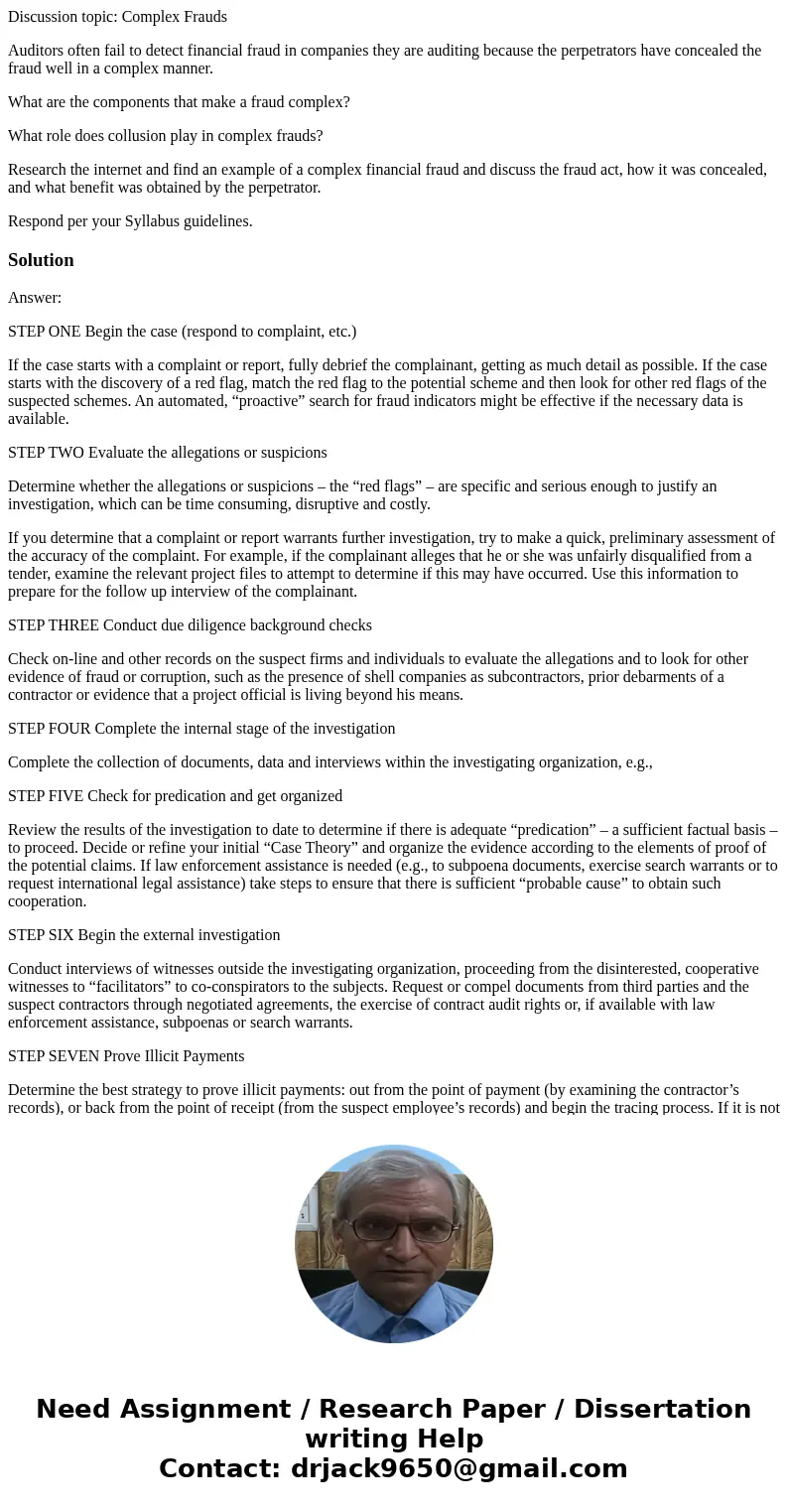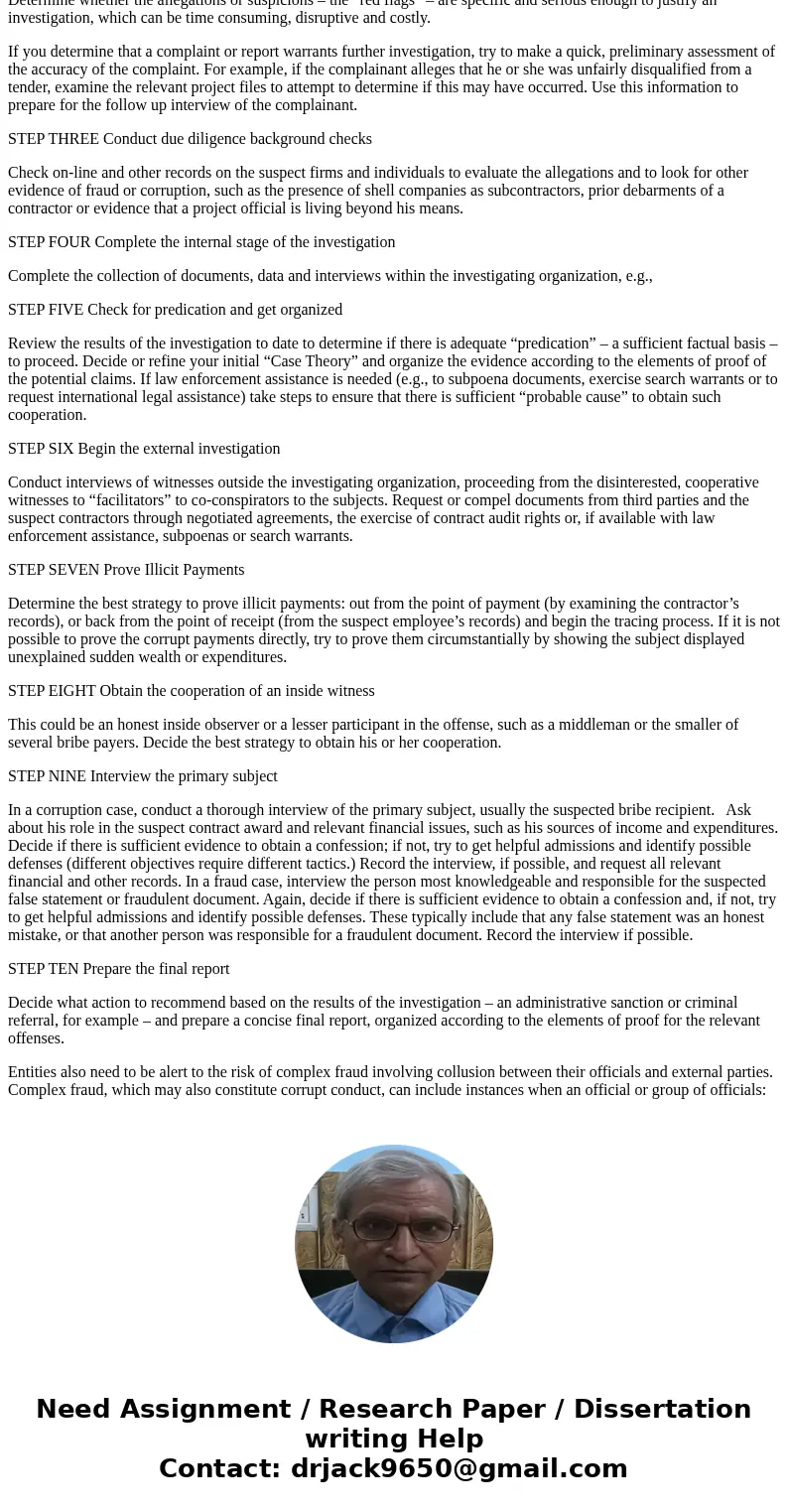Discussion topic Complex Frauds Auditors often fail to detec
Discussion topic: Complex Frauds
Auditors often fail to detect financial fraud in companies they are auditing because the perpetrators have concealed the fraud well in a complex manner.
What are the components that make a fraud complex?
What role does collusion play in complex frauds?
Research the internet and find an example of a complex financial fraud and discuss the fraud act, how it was concealed, and what benefit was obtained by the perpetrator.
Respond per your Syllabus guidelines.
Solution
Answer:
STEP ONE Begin the case (respond to complaint, etc.)
If the case starts with a complaint or report, fully debrief the complainant, getting as much detail as possible. If the case starts with the discovery of a red flag, match the red flag to the potential scheme and then look for other red flags of the suspected schemes. An automated, “proactive” search for fraud indicators might be effective if the necessary data is available.
STEP TWO Evaluate the allegations or suspicions
Determine whether the allegations or suspicions – the “red flags” – are specific and serious enough to justify an investigation, which can be time consuming, disruptive and costly.
If you determine that a complaint or report warrants further investigation, try to make a quick, preliminary assessment of the accuracy of the complaint. For example, if the complainant alleges that he or she was unfairly disqualified from a tender, examine the relevant project files to attempt to determine if this may have occurred. Use this information to prepare for the follow up interview of the complainant.
STEP THREE Conduct due diligence background checks
Check on-line and other records on the suspect firms and individuals to evaluate the allegations and to look for other evidence of fraud or corruption, such as the presence of shell companies as subcontractors, prior debarments of a contractor or evidence that a project official is living beyond his means.
STEP FOUR Complete the internal stage of the investigation
Complete the collection of documents, data and interviews within the investigating organization, e.g.,
STEP FIVE Check for predication and get organized
Review the results of the investigation to date to determine if there is adequate “predication” – a sufficient factual basis – to proceed. Decide or refine your initial “Case Theory” and organize the evidence according to the elements of proof of the potential claims. If law enforcement assistance is needed (e.g., to subpoena documents, exercise search warrants or to request international legal assistance) take steps to ensure that there is sufficient “probable cause” to obtain such cooperation.
STEP SIX Begin the external investigation
Conduct interviews of witnesses outside the investigating organization, proceeding from the disinterested, cooperative witnesses to “facilitators” to co-conspirators to the subjects. Request or compel documents from third parties and the suspect contractors through negotiated agreements, the exercise of contract audit rights or, if available with law enforcement assistance, subpoenas or search warrants.
STEP SEVEN Prove Illicit Payments
Determine the best strategy to prove illicit payments: out from the point of payment (by examining the contractor’s records), or back from the point of receipt (from the suspect employee’s records) and begin the tracing process. If it is not possible to prove the corrupt payments directly, try to prove them circumstantially by showing the subject displayed unexplained sudden wealth or expenditures.
STEP EIGHT Obtain the cooperation of an inside witness
This could be an honest inside observer or a lesser participant in the offense, such as a middleman or the smaller of several bribe payers. Decide the best strategy to obtain his or her cooperation.
STEP NINE Interview the primary subject
In a corruption case, conduct a thorough interview of the primary subject, usually the suspected bribe recipient. Ask about his role in the suspect contract award and relevant financial issues, such as his sources of income and expenditures. Decide if there is sufficient evidence to obtain a confession; if not, try to get helpful admissions and identify possible defenses (different objectives require different tactics.) Record the interview, if possible, and request all relevant financial and other records. In a fraud case, interview the person most knowledgeable and responsible for the suspected false statement or fraudulent document. Again, decide if there is sufficient evidence to obtain a confession and, if not, try to get helpful admissions and identify possible defenses. These typically include that any false statement was an honest mistake, or that another person was responsible for a fraudulent document. Record the interview if possible.
STEP TEN Prepare the final report
Decide what action to recommend based on the results of the investigation – an administrative sanction or criminal referral, for example – and prepare a concise final report, organized according to the elements of proof for the relevant offenses.
Entities also need to be alert to the risk of complex fraud involving collusion between their officials and external parties. Complex fraud, which may also constitute corrupt conduct, can include instances when an official or group of officials:


 Homework Sourse
Homework Sourse